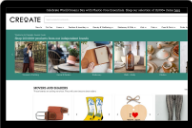
From planning the ideal category breakdown, to making sure your website is easy to navigate, there are many elements that make up a scalable, high-performing site structure — and unsurprisingly, they’re all pretty important to get right.
In this guide we’ll show you how to think about building out your categories from the ground up, as well as best practices to make sure your site is easy for customers and search engines to work their way through without a hitch. You’re essentially laying the foundation for your ecommerce website here, so let’s make sure it’s a strong one!
Why it's worth planning your product taxonomy
Product taxonomy is essentially how you organise your products into different categories.
A good category structure:
- Is flexible to your future growth
- Helps customers browse your site effectively
- Strengthens your site’s SEO
- Helps you get clear purchasing and browsing data
So it’s fair to say it’s worth taking some time over this stage!
How to sketch out a structure
Now it’s time to take out a pen and paper (or digital equivalent) and sketch out a rough product category structure.
Parent vs subcategories
You want to decide on your core parent categories first, under which can sit your subcategories, and sub-subcategories within these.
Adding subcategories down the line is generally pretty easy, but adding new parent categories, or changing the names of existing categories, is more complicated — so it’s worth thinking carefully about how your product lines may expand in the future, as well as what’s right for you now.
💡Top tip: If you get your product hierarchy correct, products should appear in their parent category, as well as their subcategory. So as an example, a taper candle should appear within ‘Candles’, but also within ‘Homeware’, assuming ‘Homeware’ is the parent.
Keep in mind that each product needn’t be in just one subcategory, either. In fact (again, depending on your products, and the search volume for different keywords) the chances are it’ll make sense to slice and dice your products into categories in a few different ways, meaning each product may appear in multiple subcategories.
📋 As an example: Let’s say your site sells different types of tea and coffee. You might want to add subcategories like ‘green tea’ and ‘black tea’ to your parent tea category, but it may be that some people are searching for tea by the format it comes in — like ‘loose leaf tea’ or ‘tea caddies’. So it may be worth dividing your tea category this way, too.
Subcategories vs attribute tags
When deciding on your category structure, you’ll come to realise that, if your product catalogue is large enough, you could essentially keep adding new layers of subcategories indefinitely.
But don’t do that. Not only are you going to give yourself a headache when it comes to trying to assemble a user-friendly navigation, you’re also going to spread your site’s authority too thinly.
In SEO terms, your homepage is the page that holds the most strength, or ‘authority’. When you add a parent category, it gets a share of this authority, a portion of which trickles down to the subcategories within that parent category, and so on.
But too many ‘layers’ of subcategories mean this authority is spread too thinly, and it’s also likely that Google won’t bother going to your ‘deepest’ categories at all.
The 3-click rule
Work with the ‘3-click rule’. That’s to say, no significant page (including any subcategory) should be more than three clicks away from the homepage.

A well-optimised site structure that follows the 3-click rule. Image credit: Digivate
As your subcategories get bigger, instead of rushing to add more levels, try working with tags instead to filter by attribute.
📋 As an example: Let’s stick with the tea example. Within the tea category, you might want to split this out into subcategories like green tea, black tea, etc as your site grows. But what about organic vs non-organic tea? This might work better as a tag, so customers can select ‘Organic’ as a filter when browsing each subcategory, rather than further subdividing this category into ‘Organic Green Tea’ etc.
How to structure your category URLs
A good URL is:
- Short and concise
- Uses hyphens in place of spaces (so /trucker-hats instead of /truckerhats)
- Avoids so-called stop words, like ‘the’ ‘of’ and ‘a’ — they take up unnecessary search engine time and space
Using a nested URL structure
In SEO terms, your homepage is the most ‘powerful’, and the categories that sit closest to it within your structure (so your parent categories) get more of the benefit of this strength.
A good URL structure for ecommerce categories is a nested URL structure. As an example, a tshirt sub-subcategory URL with a nested structure might look like this:
myecommercesite.com/womens-clothing/tops/tshirt
Google finds it really easy to navigate this URL format; it’s clear and clean. Just remember to follow the three click principle we covered above.
Other ways to group your products beyond categories
Clear, well-named categories are the best way for customers to find what they’re looking for, whether they’re already on your website, or searching via Google.
But what if they don’t know what they’re looking for?
From the ‘little something’ for the dad who has everything, to the I’ll-know-it-when-I-see-it party outfit, sometimes browsing a website with a hazier purpose is necessary. And sometimes it’s just fun.
So make sure you’re supporting these shoppers, too. Cross-category ‘Collections’ or ‘Edits’ are a great way to tap into different search motives, particularly around different events and holidays. ‘Stocking Fillers’, ‘Gifts for Kids’, or ‘Spring Essentials’, that kind of thing.
And unlike categories, you don’t have to think too carefully about how to build these into the hierarchy of your site, and you can add or remove them from the menu as you need. They also work great for email and social campaigns.
💡Top tip: ‘New in’ and ‘On offer’/ ‘Sale’ pages are always popular among casual browsers too, and can become a permanent feature of your menu. Just remember to keep them updated if this doesn’t happen automatically!
Wrapping up
When it comes to planning your category structure, spending a little time planning now could save you a headache later down the road.
But that doesn’t mean there’s no space for agility and spontaneity; product ‘collections’, or whatever you choose to call them, mean you can always get creative with how you group your products. And attribute tags are also there to help.
Fortunately, most modern ecommerce platforms both understand what your website needs technically, and that even the best laid plans don’t always work out — and they’re equipped to help you adapt accordingly.
Not selling wholesale yet? Join the thousands of independent product businesses finding overseas stockists by selling through CREOATE. Find out more.








